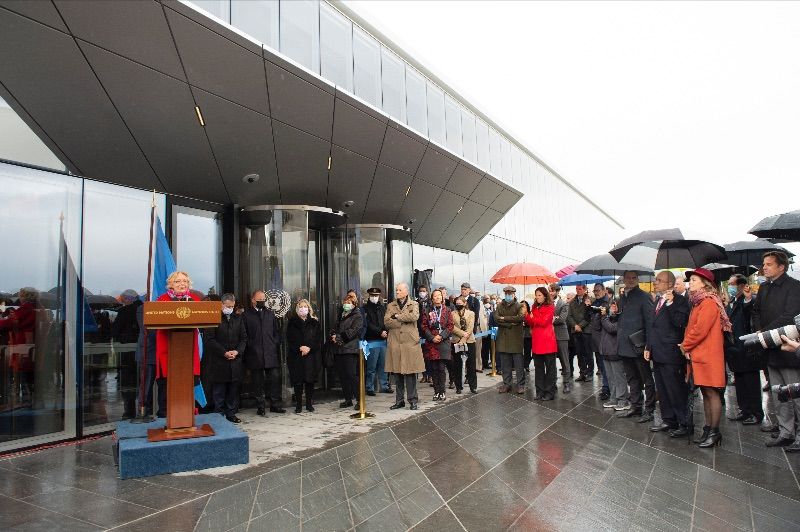
The H Building Inaugurated Amidst Staff Interrogations
From UNOG’s D-G Tatiana Valovaya, to Swiss FM Ignazio Cassis, to the Geneva authorities, le tout Genève internationale was gathered, despite the rain, for Monday’s (November 1) blue ribbon-cutting ceremony of the brand new UN H building. The building is part of the UN Strategic Heritage Plan, an ambitious plan to renovate the organization in Geneva.
For Switzerland (who indirectly footed the CHF 450 million bill through a loan), the H building is a concrete (pun intended) illustration of its commitment to fulfill its role as a host country and to develop International Geneva—of strategic importance for its foreign policy. For the UN, the brand new building is an exercise in optimization of its real estate portfolio and, ultimately, a cost-cutting measure: by densifying its office spaces and bringing several organizations under a single roof that are currently scattered around the city, the UN saves on high rent costs.
On schedule, despite Covid
An estimated 800 United Nations administrative staff, from the Office for the Coordination of Humanitarian Affairs (OHCA) and the United Nations Economic Commission for Europe (UNECE) as well as the pension fund staff, have moved into the space since May. While the UNECE staff is expected to return to the adjacent E building once its renovation is completed, the others will remain in place. The United Nations Office of the High Commissioner of Human Rights is expected to move into the H building by 2024, once the SHP is fully completed.
The H office complex might be stockier and lack the character of its older sibling—the Palais des Nations, built in 1934—but from the outside its allure is impressive nonetheless. The large glass windows are the most noticeable features of the building, which looks almost buried under its terraced green roofs.
A construction project this size always comes with its share of challenges. It is fair to say, however, that the construction of this building has been anything but smooth.
There have been water infiltration incidents, one of the main architects quit during construction, and during its initial phases, a number of contractual mishaps with H’s contractors marred the project. Amongst the difficulties was a fallout between the SHP and Implenia, the building company in charge of the site.
Will the Swiss contractor be completing the rest of the project? “The ongoing renovation is being done by another contractor,” SHP Project Director David McCuaig tells The G|O . “The procurement process is underway for further renovations, but we don’t know which company will be completing the rest of the work at this stage.”
Open plan discontentment
According to a survey of the building’s future occupants by the UN Staff Coordinating Council, it appears the jury is pretty much still out on one of the main features of the H: its open-plan design. The concept, an object of intense controversy since its invention in the early sixties, was approved for the site a few years ago. A pandemic later, and with no architectural revisions, people are clearly expressing mixed feelings—if not outright opposition—about having to move into the H.
COVID-19 has created legitimate new fears, particularly about the risk of viral contamination; fears that have been added to previous and long-documented concerns: “Our complaints have been ignored over and over,” says a Staff Council Member who wishes to remain anonymous. “The space is not adapted to work. The blinds close automatically when the sun comes out, plunging us into darkness, and there are temperature problems throughout the building. Sometimes it’s too cold and sometimes it’s too hot. Not to mention that it is difficult to make a phone call in an open space. Most of us prefer to work from home.”
Addressing these concerns, David McCuaig acknowledged to The G|O that there had been a few initial problems with the building’s systems, but said that “these have now almost all been resolved, and the new building is a state-of-the-art facility which delivers on the UN’s sustainability agenda.”
As for the challenges of space organization, he added that "this is where the hard deliverables of the project come into direct contact with everybody working in the Palais. Some disruption is inevitable and a dedicated Transition Team has been created to minimize these issues.”
-SZ
